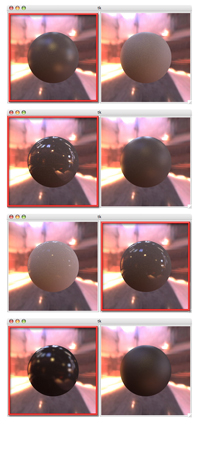 So, on Friday, Abhijeet and I submitted a sketch to SIGGRAPH (the premier computer graphics conference, though sketches aren’t held to anything like the esteem that papers are). And hey, it’s not blind review, like my last paper, so I can tell you about this. Though blind review or no, I can’t post the work until it’s published understandably somewhere, or else bad people might steal my brilliant ideas.
So, on Friday, Abhijeet and I submitted a sketch to SIGGRAPH (the premier computer graphics conference, though sketches aren’t held to anything like the esteem that papers are). And hey, it’s not blind review, like my last paper, so I can tell you about this. Though blind review or no, I can’t post the work until it’s published understandably somewhere, or else bad people might steal my brilliant ideas.
The nice thing about a SIGGRAPH sketch is that it’s only a single page, so it doesn’t take long. The bad thing is that it’s only a single page, which means that I have to compress all of my work, including math, into a few paragraphs.
However, I’m actually pretty happy with it. It’s a method of helping computer artists find the right parameters for surfaces by showing them examples and asking them to indicate which ones are closest to what they have in mind. The idea is that instead of the user twiddling all kind of parameters they don’t understand, the computer handles that part, trying different parameters and asking the user to say which final result they prefer. Abhi’s work is in providing the model of material properties.
Funny story: I wrote the code for some of the math during my latest bout of insomnia. I noticed it wasn’t really doing what I wanted, so I looked at the equations, which were not only wrong, but so wrong that I have no idea what I was thinking about or trying to do. Apparently in my sleepless state, I based the first part on one equation, got distracted, and then based the rest on something completely different. It was the coding equivalent of saying “it was the best of times is an illusion and lunchtime doubly so”.
I also commented some of my code “ ## FIXME: I can’t think straight and have no idea what I’m doing ##“. But that part works.
The worst thing about Garden State is not that some people really do like it (though that’s pretty bad), but that people think that as an indie film fan, I would like it.
 Kurt Vonnegut died last week.
Kurt Vonnegut died last week.
I started reading Vonnegut in high school, and I was blown away by his powerful storytelling and his bleak wit. Above all, though, there was the feeling that here was someone who had the same thoughts and ideas that I had, a worldview and temperament that only alienated me from most of my peers. Of course, he was smarter and wiser than me, and expressed himself infinitely better than I ever could, but it was clear he drew strength from some common source of introversion and non-conformity.
Years later, after graduating university and moving to the big city, I re-read several of his books. I was kind of surprised to find his work had not lost any of its impact. If anything, I was even more able to appreciate his blend of pessimistic humanism. Though to be fair, I never really shed my adolescent angst.
The AV Club has a great feature today, which kind of sums it all up. It’s probably time I read his books again.
 One good thing about my my insomnia of the past few days — it’s left me cranky enough to really enjoy David Cross’s two albums of angry, angry hipster stand-up, Shut Up You Fucking Baby! and It’s Not Funny. Not that I don’t usually enjoy his attacks on George Bush, Evanescence and electric scissors, but I get a little something extra out of listening to his albums with an appropriately pissed-off view of the world.
One good thing about my my insomnia of the past few days — it’s left me cranky enough to really enjoy David Cross’s two albums of angry, angry hipster stand-up, Shut Up You Fucking Baby! and It’s Not Funny. Not that I don’t usually enjoy his attacks on George Bush, Evanescence and electric scissors, but I get a little something extra out of listening to his albums with an appropriately pissed-off view of the world.
Anyway, while I was digging around for info on the albums, I discovered a column Cross wrote for Pitchforkmedia.com a couple of years back. In what I can only imagine was a classic case of the left hand not knowing what the right hand was doing, Pitchfork’s “critics” dismissed his albums with their patented blend of vapid pseudointellectual condescension and word salad, calling him “a giant fucking asshole” for good measure. And then the editorial staff invited him to write a top-ten list. Which he did. Using “highlights” from Pitchfork’s own hipper-than-thou reviews.
If only more people would take the time to give Pitchfork a good old-fashioned Lee Marvinesque crotch-punching. In print or in real life, I’m okay either way.
 Has a ship ever been more appropriately named than the HMS Terror? A mortar-launching bomb vessel converted to icebreaker, she sailed to Antarctica (a massive frozen volcano, Mount Terror, is named for her) before setting off with her sister ship, the HMS Erebus, on the 1845 Franklin expedition to chart the Northwest Passage. Terror and Erebus became frozen into the ice west of Baffin Island, where the crews slowly starved and froze to death over the course of two horrifically cold winters and thawless summers before making a desperate and doomed trek south. Only years later were a few traces of the expedition found, the bodies showing signs of lead poisoning, murder and cannibalism.
Has a ship ever been more appropriately named than the HMS Terror? A mortar-launching bomb vessel converted to icebreaker, she sailed to Antarctica (a massive frozen volcano, Mount Terror, is named for her) before setting off with her sister ship, the HMS Erebus, on the 1845 Franklin expedition to chart the Northwest Passage. Terror and Erebus became frozen into the ice west of Baffin Island, where the crews slowly starved and froze to death over the course of two horrifically cold winters and thawless summers before making a desperate and doomed trek south. Only years later were a few traces of the expedition found, the bodies showing signs of lead poisoning, murder and cannibalism.
My most recent bout of insomnia has allowed me to finally finish off Dan Simmons’ 784-page novel, The Terror, based on the Franklin expedition. Simmons’ Sir John Franklin is fueled by a combination of Victorian hubris and a desperate need to redeem himself following a previous arctic failure, which leads him to take the expedition into dangerously risky territory (the echoes of Iraq are never overdone, but they’re hard to miss). As a series of catastrophes — natural, manmade and supernatural — unfold, the story shifts to Crozier, captain of the Terror and the huddled band of survivors, at which point, the novel kicks in and never lets up. The survivors must deal with scurvy, mutiny, and winters of constant darkness and unrelenting cold. And that’s not even counting the thing out on the ice that’s killing the men one by one.
The novel paints arctic exploration as inept intrusions on a relentlessly hostile and unforgiving world, exacerbated by the arrogance of explorers who mistake their accidental survival for triumph over nature. Only Crozier and his crew’s determination to survive for the sake of survival keeps them going. As things get more and more dire, it becomes clear that this instinct is not necessarily heroic.
I’ve never read any of Dan Simmons’ other work, but I might have to now. The Terror is a grim story, but it never feels nihilistic — Simmons is surprisingly warm and humanistic even while he’s killing his characters, and the details of 19th-century polar exploration are fascinating without ever interfering with the story. It may be 800 pages long, but it’s a damn entertaining 800 pages.
 So, on Friday, Abhijeet and I submitted a sketch to SIGGRAPH (the premier computer graphics conference, though sketches aren’t held to anything like the esteem that papers are). And hey, it’s not blind review, like my last paper, so I can tell you about this. Though blind review or no, I can’t post the work until it’s published understandably somewhere, or else bad people might steal my brilliant ideas.
So, on Friday, Abhijeet and I submitted a sketch to SIGGRAPH (the premier computer graphics conference, though sketches aren’t held to anything like the esteem that papers are). And hey, it’s not blind review, like my last paper, so I can tell you about this. Though blind review or no, I can’t post the work until it’s published understandably somewhere, or else bad people might steal my brilliant ideas. Kurt Vonnegut died last week.
Kurt Vonnegut died last week. One good thing about my my insomnia of the past few days — it’s left me cranky enough to really enjoy David Cross’s two albums of angry, angry hipster stand-up, Shut Up You Fucking Baby! and It’s Not Funny. Not that I don’t usually enjoy his attacks on George Bush, Evanescence and electric scissors, but I get a little something extra out of listening to his albums with an appropriately pissed-off view of the world.
One good thing about my my insomnia of the past few days — it’s left me cranky enough to really enjoy David Cross’s two albums of angry, angry hipster stand-up, Shut Up You Fucking Baby! and It’s Not Funny. Not that I don’t usually enjoy his attacks on George Bush, Evanescence and electric scissors, but I get a little something extra out of listening to his albums with an appropriately pissed-off view of the world. Has a ship ever been more appropriately named than the HMS Terror? A mortar-launching bomb vessel converted to icebreaker, she sailed to Antarctica (a massive frozen volcano, Mount Terror, is named for her) before setting off with her sister ship, the HMS Erebus, on the 1845 Franklin expedition to chart the Northwest Passage. Terror and Erebus became frozen into the ice west of Baffin Island, where the crews slowly starved and froze to death over the course of two horrifically cold winters and thawless summers before making a desperate and doomed trek south. Only years later were a few traces of the expedition found, the bodies showing signs of lead poisoning, murder and cannibalism.
Has a ship ever been more appropriately named than the HMS Terror? A mortar-launching bomb vessel converted to icebreaker, she sailed to Antarctica (a massive frozen volcano, Mount Terror, is named for her) before setting off with her sister ship, the HMS Erebus, on the 1845 Franklin expedition to chart the Northwest Passage. Terror and Erebus became frozen into the ice west of Baffin Island, where the crews slowly starved and froze to death over the course of two horrifically cold winters and thawless summers before making a desperate and doomed trek south. Only years later were a few traces of the expedition found, the bodies showing signs of lead poisoning, murder and cannibalism.